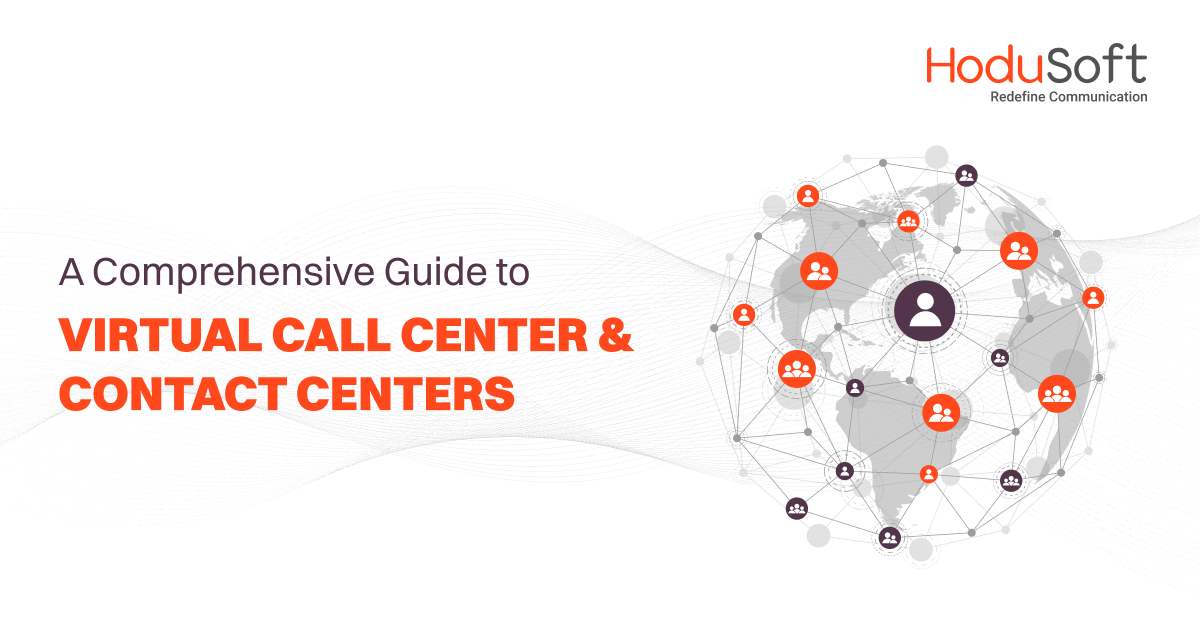A Comprehensive Guide to Virtual Call Center and Contact Centers
Even though virtual call centers and contact centers have been around for quite some time, they have gained widespread popularity in the last four to five years only. That’s because the COVID-19 pandemic made virtual call centers and contact centers a necessity rather than a convenience.
Virtual call and contact centers have become the new norm in the present time instead of being an optional feature for businesses seeking flexibility in their operations. The COVID-19 pandemic propelled virtual call centers and contact centers from being supplemental solutions to essential infrastructure.
Now, they’re the cornerstone of customer service and support, enabling seamless communication and collaboration with the help of call and contact center software, regardless of physical location. As per recent stats the number of remote call center agents is expected to grow by 60 percent from 2022 to 2024.
In this blog post, we will discuss everything about virtual call centers and contact centers, starting from what they are, history and evolution, benefits they offer to contemporary businesses, and how to choose the right virtual call center and contact center software.
What Are Virtual Call Centers and Contact Centers?
As the name suggests, virtual call and contact centers are call and contact centers that are virtual in nature. That means they don’t need customer service representatives and agents to be physically present in one location unlike traditional call centers and contact centers that are confined to physical locations.
Virtual call centers leverage cloud-based technology to enable remote agents to handle customer inquiries from anywhere in the world. This flexibility offers several advantages over their brick-and-mortar counterparts. That also makes these support centers far more cost-effective.
Another key benefit of virtual call center software is its flexibility, enabling agents to work remotely. This not only promotes a better work-life balance for employees but also opens up opportunities for businesses to tap into a global talent pool. Furthermore, virtual contact center solutions are designed to enhance the customer experience by providing seamless omnichannel support across voice, email, chat, and social media platforms.
History and Evolution of Virtual Call Center and Contact Center
The first traditional call center was established in the 1960s after the innovation of the automated call distribution (ACD) system. Traditional call centers were based in physical locations (usually large buildings equipped with rows of desks, computers, and phone lines) where agents worked in an office in a centralized manner.
But the advent of fast and reliable internet connection, cloud technology, specialized software such as virtual call center software and virtual contact center software, made virtual call and contact centers a reality. Virtual call centers are not tied to any physical location and operate entirely online.
As communication technology continued to evolve, customers began using various channels (such as voice calls, video calls, email, live chat, social media, and messaging apps) to interact with businesses. Call centers transformed to contact centers to accommodate these channels.
Post 2020, with remote work becoming the norm rather than an exception, companies quickly adapted their operations to support remote work for customer service agents. That made virtual call centers and contact centers extremely popular in the call center industry.
After 2022, the ubiquity of a wide range of Artificial intelligence (AI) tools and automation technologies have become increasingly prevalent in virtual call and contact centers.
Challenges Faced By Traditional Call Centers
Starting from high setup costs to fixed workstations, traditional call centers face a lot of challenges. Here are some of the challenges traditional call centers face:
1. High Setup Costs
Starting an on-premise call center is not an easy task and it certainly does not come cheap. In today’s time, starting a traditional call center will either require breaking the bank and withdrawing the entire life’s savings for the purpose or taking a huge loan and remaining indebted for a long time to come.
2. Rigidity and Inflexible Working Conditions
Traditional call centers are infamous for rigid and inflexible working conditions. That’s natural considering traditional call centers have predefined shifts and employees are expected to punch in at a certain time of the day and punch out after ending their shift. Even though it sets a routine, it also results in monotony.
3. Limited Access to Global Talent Pool
Most often than not a physical call center that has a branch in one location but serves customers in multiple countries. In such a scenario, it may have access to a broad clientele base but it doesn’t have access to a global talent pool.
4. Vulnerable to Disruptions
Traditional call centers are more vulnerable to disruptions compared to their virtual counterparts. It just takes one natural disaster or pandemic to stop the entire call center operations for quite some time. Case in point, during COVID-19 pandemic many physical call centers had to shut offices and halt operations during lockdowns but virtual call centers remained unaffected.
Benefits Provided by Virtual Call Centers Over Traditional Call Centers
Compared to traditional call and contact centers, the benefits of virtual call and contact centers are many. Here are some of the key benefits of virtual call and contact centers:
1. Less Capital Investment
Setting up a virtual call or contact center is extremely cost-effective compared to setting up a traditional call or contact center. The later needs significant investment in physical infrastructure such as:
- Office space
- Furniture
- Equipment
- Telecommunications infrastructure
Virtual call and contact centers eliminate the need for physical premises and expensive hardware. As it is a virtual setup, you don’t need to buy or lease the physical space. Moreover, the investment in infrastructure is saved, too. The only investment requirement is for good quality and sophisticated virtual call center software.
2. Reduced Operational Costs
The virtual call center software doesn’t require any hardware, addon or any other recurring expenses. It can be managed and maintained with the least expense. The virtual contact center supports home based agents. Thus, the expense over recruitment, HR and administration-related costs, etc. will be saved.
3. Decrease in Call Costs
A majority of virtual call center software uses the VoIP technology for generating and receiving calls. VoIP uses the internet for transmission of audio and data, which reduces the call cost. This further contributes to expense reduction for the virtual contact centers.
4. Improved Productivity
Virtual call center software includes features like automatic call distribution, call routing, and integration with customer relationship management (CRM) systems. These features help optimize agent workflows, reduce idle time, and ensure that agents have access to relevant customer information. Using the virtual call center software, you can allow your agents to work from home or any place they are comfortable working from. This will provide them the work flexibility, which will result in:
- Improved work satisfaction
- Easy workforce management
- Improved efficiency
- Employee retention
- And more
5. Enhanced Customer Satisfaction
As you can allow the home based agent working approach, you can now operate your contact center 24/7. You can recruit agents for different shifts. This will keep your services running, which will result in better catering of the customers and improved customer satisfaction.
6. Increased Sales Revenue
As you already know the virtual contact center requires very less capital investment and operational expenses. This results in the improved and enhanced ROI (Return over Investments).
7. Streamlined Communication
Virtual call center solutions often come with advanced communication tools like chat, email, and social media integration. This streamlines communication channels, making it easier for agents to interact with customers across various platforms seamlessly.
8. Better Customer Engagement
By providing multiple channels for customers to reach out, virtual call centers enhance customer engagement. Whether it’s through phone calls, live chat, or social media messaging, customers can choose the most convenient method to contact support, leading to higher satisfaction levels.
9. Data-Driven Insights and Decision Making
Virtual call center platforms collect vast amounts of data on customer interactions, including call durations, wait times, customer feedback, and more. By analyzing this data, managers can gain valuable insights into customer preferences, agent performance, and overall call center efficiency. This data-driven approach enables informed decision-making, leading to continuous improvement in service quality and operational efficiency.
10. Scalability
Virtual call center solutions are often designed to scale easily, allowing businesses to adapt to fluctuating call volumes without the need for significant infrastructure investments. Whether you’re experiencing rapid growth or seasonal fluctuations, virtual call centers can dynamically adjust to meet your needs, ensuring consistent service quality.
11. Flexibility for Remote Work
Virtual call center technology enables agents to work from anywhere with an internet connection, whether it’s from home, a remote office, or even while traveling. This flexibility not only increases job satisfaction for agents but also expands the pool of potential talent by removing geographical limitations, leading to improved staffing options and reduced overhead costs.
12. Disaster Recovery and Business Continuity
Virtual call centers are less susceptible to disruptions caused by natural disasters, infrastructure failures, or other unforeseen events. Since agents work remotely, they can continue to provide customer support even if a physical office becomes inaccessible. Additionally, cloud-based infrastructure ensures high availability and redundancy, minimizing the risk of downtime and ensuring uninterrupted operations.
13. Personalized Customer Experiences
Virtual call center platforms often include features like advanced analytics, customer segmentation, and personalized scripting tools. By leveraging these capabilities, businesses can tailor their interactions with customers based on their preferences, purchase history, and other relevant data points, leading to more meaningful and personalized experiences that drive customer loyalty and retention.
14. Compliance and Security
Virtual call center solutions typically adhere to industry regulations and security standards, such as PCI DSS for payment card data and GDPR for data privacy. These platforms often include built-in security features like encryption, access controls, and audit trails to protect sensitive customer information, ensuring compliance and peace of mind for businesses and their customers alike.
15. Wide Access to Global Talent Pool
Virtual call centers have access to a vast global talent pool. Instead of being limited to hiring agents from a specific geographic location, businesses can recruit the best talent from around the world. This not only increases the diversity of the workforce but also enables companies to find agents with specialized skills or language proficiency to better serve their customers.
Choosing the Right Virtual Call/Contact Center Software
When it comes to choosing the right virtual call center software, you want to ensure you’re making an informed decision based on several key factors. Here are some tips to choose the right virtual call/contact center software:
1. Scalability and Flexibility
Ensure the software can accommodate your growing business needs without compromising performance. Look for scalability in terms of adding new agents, expanding to multiple locations, or handling increased call volumes during peak times. Flexibility is crucial for adapting to changing business requirements and integrating with other systems.
2. Integration Capabilities
Evaluate whether the software can seamlessly integrate with your existing CRM, helpdesk, or other business tools. Integration ensures smooth data flow between different systems, streamlining workflows and enhancing productivity. Consider APIs and third-party integrations available to extend functionality as needed.
3. Security and Compliance
Data security is paramount, especially when dealing with sensitive customer information. Ensure the software complies with industry standards and regulations such as GDPR, HIPAA, or PCI DSS. Look for features like encryption, access controls, and regular security updates to safeguard data.
4. Ease of Use and Implementation
User-friendly interface and intuitive design are essential for quick adoption by agents and supervisors. Consider the implementation process, including setup time, training requirements, and ongoing support. Choose a solution that minimizes downtime and disruptions to your operations during deployment.
5. Pricing Model
Evaluate the pricing structure based on your budget and usage requirements. Compare upfront costs, subscription fees, and any additional charges for add-on features or usage overages. Look for transparency in pricing and flexibility to scale up or down as needed without long-term contracts.
6. Features and Offerings
Assess each provider’s feature set, including call routing, IVR, call recording, analytics, and reporting. Look for advanced capabilities like omnichannel support, predictive dialing, workforce management, and AI-powered features. Consider customization options to tailor the software to your specific business needs.
7. Customer Reviews and Ratings
Research customer feedback and ratings on review platforms, forums, and social media. Pay attention to overall satisfaction, ease of use, reliability, and customer support responsiveness. Look for patterns in reviews to identify strengths and weaknesses of each provider.
8. Case Studies and Success Stories
Review case studies and success stories from existing customers to understand real-world implementations. Focus on industries similar to yours and the challenges they solved using the software. Look for measurable results such as improved efficiency, cost savings, or enhanced customer satisfaction.
All in All,
Virtual call and contact centers have transformed the customer service industry by offering cost-effective, flexible, and scalable solutions that leverage global talent and ensure business continuity. These advantages have made them increasingly popular among businesses of all sizes seeking to enhance their customer service capabilities.



